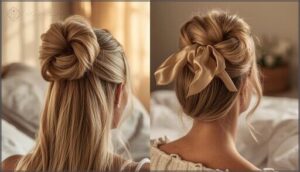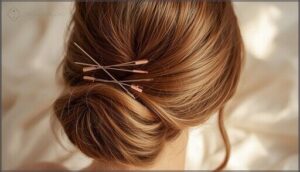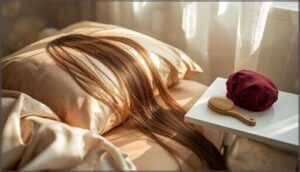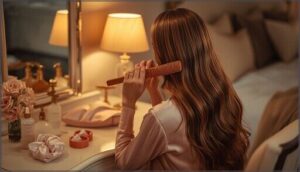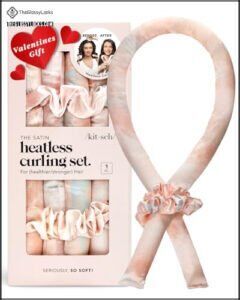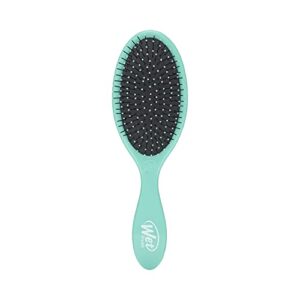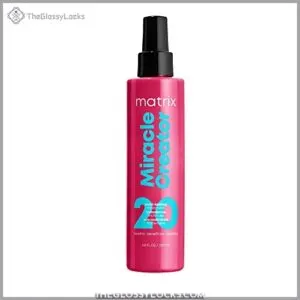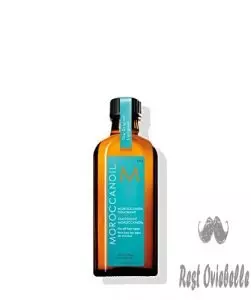This site is supported by our readers. We may earn a commission, at no cost to you, if you purchase through links.
You wake up, reach for your hair, and immediately feel the damage—a nest of tangles, frizz radiating in every directions, and broken strands scattered across your pillow. Most people blame their hair texture or the weather, but the real culprit is how you’re sleeping.
Eight hours of friction, tension, and moisture loss can undo weeks of careful hair care, leaving you with split ends and breakage that no amount of conditioning can fix. The best way to sleep with long hair isn’t about expensive products or complex routines—it’s about understanding how your hair behaves at night and protecting it from the mechanical stress that happens while you’re completely unaware.
A few strategic adjustments to your nighttime routine can cut morning tangles by more than half and preserve the health you’ve worked so hard to build.
Table Of Contents
- Key Takeaways
- Best Hairstyles for Sleeping With Long Hair
- Essential Nighttime Hair Protection Methods
- Preparing Long Hair Before Bed
- Creating a Hair-Friendly Sleep Environment
- Top 4 Products for Sleeping With Long Hair
- Frequently Asked Questions (FAQs)
- How do silk or satin pillowcases benefit my hair while I sleep?
- What is the best timing for showers to ensure healthy hair?
- How can a scarf or wrap protect my hair while I sleep?
- Why is it important to brush my hair before bed?
- What are the benefits of switching to scrunchies for my hair while I sleep?
- How often should I wash long hair?
- Can sleeping position affect hair growth rate?
- Does hair texture change sleep care needs?
- Should I trim hair more with overnight styling?
- Are overnight treatments safe for colored hair?
- Conclusion
Key Takeaways
- Sleeping with long hair in loose, protective styles like high buns or gentle braids prevents up to 60% of morning tangles while reducing breakage by distributing tension evenly across strands instead of pulling at vulnerable roots.
- Switching to silk or satin pillowcases and hair accessories cuts friction-related damage by up to 50%, preserving your hair’s natural moisture and preventing the frizz and split ends that cotton fabrics cause through constant rubbing.
- Always brush and completely dry your hair before bed—sleeping on damp strands doubles your breakage risk since wet hair is weakest and creates destructive friction that frays cuticles throughout the night.
- Your bedroom environment matters as much as your routine: maintaining 40-60% humidity and cooler temperatures between 60-67°F protects moisture retention and supports healthier hair growth while you sleep.
Best Hairstyles for Sleeping With Long Hair
The right hairstyle can mean the difference between waking up to silky, manageable locks or a tangled disaster that takes half your morning to fix. You want something that keeps your hair protected without causing breakage or flattening your style completely.
Here are four nighttime hairstyles that actually work for long hair.
Loose High Bun Techniques
A high bun positioned at or just above your crown takes pressure off your scalp and minimizes hair tension while sleeping with long hair. Keep it loose—slightly undone to prevent breakage and creasing.
Use a soft satin-covered elastic for bun security without friction, and leave a bit of hair volume at the base to protect your roots and hairline from stress.
Protective Braids for Overnight Wear
Braiding your long hair before bed is one of the smartest protective updos you can master. Sleep braids spread tension evenly, reducing hair breakage by keeping friction away from vulnerable cuticles.
Try a loose French or Dutch braid starting behind your ear—it’ll stay put without pulling at your roots. Just don’t braid too tight; excessive tension can lead to traction alopecia over time.
Using French Hair Pins for Damage-Free Updos
Instead of elastic bands that snag and stress your strands, French pins offer a damage-free method for securing updos. These metal or plastic grips distribute tension evenly across your hair shaft, reducing breakage by up to 30% compared to tight ties. Insert them parallel to your scalp in a crisscross pattern for maximum hold with minimal pulling.
Pin Placement Guide for Long Hair:
- Start with completely dry, detangled hair to prevent stretching
- Gather hair into a loose bun at the crown
- Insert 4-6 pins with curved side facing your scalp
- Cross pins in an X-pattern for secure, low-tension hold
- Pair with silk pillowcases for supreme hair protection methods
Avoiding Tight Styles and Tension
French pins set you up for success, but the real key is ditching tension altogether. Tight ponytails and pulled-back sleep styles increase mechanical stress on your hair shaft, leading to measurable breakage and even traction alopecia over time.
Choose loose, gentle updos that lift hair off your neck without compressing your scalp—these low-tension options preserve cuticle integrity while reducing friction and overnight damage.
Essential Nighttime Hair Protection Methods
You can have the perfect hairstyle picked out, but without the right protection, your hair will still wake up damaged and tangled. The secret lies in what your hair touches throughout the night—those surfaces make all the difference between smooth, healthy hair and a frizzy mess.
Let’s look at the protection methods that actually work to keep your long hair safe while you sleep.
Benefits of Silk and Satin Pillowcases
Switching to a silk pillowcase or satiny pillowcase transforms your sleep into a beauty treatment. These fabric choices dramatically cut friction reduction, letting your hair glide smoothly instead of catching and snagging on cotton. That means fewer split ends and less hair breakage by morning.
The moisture retention benefits are real too—silk doesn’t steal your hair’s natural oils, keeping strands hydrated for better hair protection and overall sleep and hair health. To maintain consistency in our writing, we should follow proper writing clear science guidelines.
Wearing Bonnets, Scarves, or Headbands
Wrapping your hair in a silk bonnet benefits you with serious friction reduction—studies show satin scarf styles and headband materials beat cotton every time for hair coverage and hair protection.
These sleeping habits transform nighttime hair care by preventing hair breakage while you toss and turn.
Choose loose-fitting designs that accommodate your hair volume without strangling your scalp, keeping strands safe and your hair styling intact until morning.
Using Satin Scrunchies Instead of Elastics
That elastic band you’ve been using? It’s probably wrecking your hair while you sleep. Swap it for a satin scrunchie and you’ll preserve up to 20% more cuticle integrity overnight. Here’s why gentle hair ties matter for sleep hair care:
- Satin scrunchies reduce friction and hair breakage by creating a smoother surface
- They distribute tension evenly, preventing those dreaded band marks and creases
- Paired with a satiny pillowcase, they form a coordinated low-friction system
Choose smooth, high-thread-count weaves without metal embellishments for maximum hair protection.
Keeping Hair Contained to Prevent Tangling
Long hair left loose is like a magnet for tangles—every turn, every toss, another knot forms. Containing your hair in gentle styles like nighttime braids or protective updos cuts friction and prevents hair breakage while you sleep.
Pair your approach with silk bonnets or soft hair ties for friction reduction, and layer in leave-in treatments to keep strands slippery and protected. It’s simple hair protection that actually works.
Preparing Long Hair Before Bed
Your bedtime routine matters just as much as your morning one regarding protecting long hair. What you do in those few minutes before you hit the pillow can mean the difference between waking up to smooth, manageable hair or dealing with a tangled, damaged mess.
Here’s how to prep your long hair properly so it stays healthy while you sleep.
Brushing and Detangling Safely
Before climbing into bed, give your long hair a proper detangle session—it cuts morning tangles by 60 percent. Start at the ends with a wide-tooth comb and work upward to reduce breakage by about 25 percent.
A detangling spray creates slip, making brushing techniques gentler and preventing hair damage. This simple ritual transforms your hair care tips routine completely.
Avoiding Wet or Damp Hair at Night
Going to bed with damp strands doubles your breakage risk—your hair’s weakest when wet. Sleeping on moisture-loaded locks creates friction that frays delicate cuticles and invites unwanted frizz.
Sleeping on wet hair doubles your breakage risk because damp strands are weakest and create friction that frays cuticles
Make drying part of your nighttime routine: air-dry until 80 percent dry, then gently blot with a microfiber towel. This simple moisture control step protects your hair health overnight and prevents unnecessary damage.
Applying Leave-in Conditioners and Serums
Once your hair’s mostly dry, lock in moisture with a leave-in conditioner or lightweight hair serum. These leave-in treatments create a protective barrier that reduces frizz and smooths cuticles while you sleep.
Hair oil or a targeted hair repair mask can strengthen strands overnight—just use a light hand to avoid pillow stains.
The nighttime moisture payoff? Easier detangling and visible hair serum benefits by morning.
Using Microfiber Towels for Gentle Drying
Before you even think about pillow time, swap your rough cotton towel for a microfiber one. Here’s why it matters for gentle drying and hair absorption:
- Cuts drying time by up to 50%
- Reduces breakage potential by 30-40%
- Pulls moisture without stripping natural oils
- Minimizes cuticle friction and split ends
- Keeps fiber quality high with proper towel hygiene
Just blot—don’t rub—to protect long hair from unnecessary hair breakage during your nighttime hair maintenance routine.
Creating a Hair-Friendly Sleep Environment
Your bedroom’s atmosphere plays a bigger role in hair health than you might think. The air quality, temperature, and humidity levels where you sleep can either protect your strands or leave them vulnerable to breakage and dryness.
Let’s look at three key environmental factors you can adjust tonight for healthier hair by morning.
Maintaining Proper Bedroom Humidity
You can tame frizz and boost hair hydration by keeping your bedroom humidity between 40–60%. Use a digital hygrometer to monitor levels, then adjust with a humidifier during dry seasons.
This moisture balance aids frizz prevention and creates a sleep environment that protects hair growth overnight.
Clean your humidifier weekly to maintain air quality and optimize sleep quality benefits.
Preventing Excessive Friction and Dryness
Beyond humidity control, friction reduction stands as your frontline defense against overnight damage. Silk pillowcases cut mechanical stress on hair fibers, lowering breakage rates by creating hair slippage instead of drag.
This moisture balance strategy works double-duty—preventing dryness while supporting frizz prevention and control. Studies show satin sleep textiles reduce tangles by 20–40%, protecting hair hydration as you rest.
Adjusting Airflow and Temperature for Hair Health
While you rest, your sleep environment quietly works either for or against your hair health. Cooler bedroom temperature settings between 60–67°F support moisture retention and reduce sweaty scalp stress, while proper ventilation systems prevent humidity buildup that triggers frizz.
- Position fans for gentle airflow control away from your head
- Set thermostats to stable overnight temperatures for hair growth support
- Maintain humidity levels around 40–50% using a humidifier
- Keep vents clear for consistent air circulation that protects scalp health
Top 4 Products for Sleeping With Long Hair
The right products can make all the difference between waking up with gorgeous, healthy hair or dealing with a tangled mess. You don’t need a dozen bottles cluttering your nightstand—just a few strategic essentials that protect, nourish, and style while you sleep.
Here are four game-changing products that’ll transform your nighttime hair routine.
1. Kitsch Satin Heatless Curling Set
If you want salon-worthy curls without torching your hair, the Kitsch Satin Heatless Curling Set delivers. This 34-inch satin rod creates loose waves overnight while you sleep, making it perfect for long hair that’s prone to breakage from hot tools.
The satin material works double-duty—reducing friction like silk pillowcases do while shaping your curls. You’ll get two satin scrunchies to secure everything in place.
For best results with heatless curl formation, wrap slightly damp (not wet) hair around the rod before bed, and you’ll wake up with natural-looking waves.
- Creates loose, natural waves without heat damage while reducing frizz and breakage compared to hot tools
- Satin material cuts down on friction and moisture loss during sleep, similar to silk pillowcases
- Works for all hair types and doubles as a time-saver since you style while sleeping
- Can be uncomfortable for side sleepers and may slip during the night
- Takes some practice to wrap hair properly and keep it secured on the rod
- May cause breakage around the hairline if you’re not careful with tension and placement
2. Wet Brush Detangling Hair Brush
Long hair tangles easily overnight, so detangling before bed is essential for hair protection. The Wet Brush features flexible IntelliFlex bristles that bend around knots instead of ripping through them, enabling gentle detangling on both wet and dry hair.
Start from the ends and work upward using slow strokes—this technique prevents hair breakage better than aggressive brushing. The brush materials, flexible plastic bristles, reduce friction compared to traditional hard-bristle options.
For sleeping hair care, pair this with proper brush maintenance by cleaning it weekly to remove oils and buildup.
- Flexible IntelliFlex bristles bend around knots instead of ripping through them, which reduces pain and breakage
- Works well on both wet and dry hair, making it versatile for different routines
- Glides through tangles smoothly, especially on long hair, with less snagging than traditional brushes
- Some users report the handle breaking within a few months, raising durability concerns
- Mixed feedback on whether it actually reduces hair breakage for everyone
- The soft, flexible bristles might not work as well for people who prefer firmer brushing
3. Matrix Miracle Leave In Conditioner Spray
Applying a leave-in treatment before bed transforms sleep into repair time. The Matrix Miracle Leave-In Conditioner Spray delivers product efficacy through 20 hair protection benefits, including breakage prevention and detangling. This conditioner’s safety profile suits all hair types, making it ideal for your nighttime hair routine.
The spray application distributes evenly through damp or dry hair—focus on mid-lengths to ends where damage accumulates most.
You’ll wake to smoother strands because leave-in benefits work while you rest, strengthening hair through treatments that fight friction and moisture loss during sleep.
- Delivers 20 benefits in one lightweight spray—detangles, fights frizz, adds shine, and protects against heat damage without buildup
- Works on damp or dry hair and suits all hair types, including curly, damaged, and frizzy textures
- Prevents breakage and nourishes with a blend of super acid, humectants, and oils while you sleep
- At $25, it’s pricier than many drugstore leave-in treatments
- Some users find it too lightweight and say it doesn’t provide enough moisture for very dry or damaged hair
- Not everyone experiences all 20 claimed benefits, and older product versions may perform differently
4. Moroccanoil Hair Treatment Oil
Think of argan oil as a nightly shield for your hair—Moroccanoil Hair Treatment Oil delivers those benefits through vitamin E and fatty acids that deeply moisturize while you sleep. Apply a small amount to damp hair before bed, and you’ll reduce frizz while improving slip for easier morning detangling.
This hair serum works as an overnight repair treatment, sealing split ends and preventing protein loss from friction. Studies confirm argan oil’s efficacy in protecting against mechanical stress, making it one of the smartest leave-in treatments for hair protection methods.
- Contains argan oil with vitamin E and fatty acids that moisturize deeply and protect against mechanical damage while you sleep
- Works as a multipurpose product—use it as an overnight treatment, styling aid, or finishing serum to seal split ends
- Boosts shine by up to 118% and provides heat protection, with non-greasy, alcohol-free formula
- Expensive at $50 for a 3.4 oz bottle, which may not offer the best value given the small size
- Can be too heavy for fine or thin hair, potentially making it look greasy or weighed down
- Strong Originale scent might be overwhelming for some users, and the shine effect may fade quickly
Frequently Asked Questions (FAQs)
How do silk or satin pillowcases benefit my hair while I sleep?
Think of silk pillowcases as a shield against midnight friction—they reduce hair breakage by up to 50%, preserve moisture, minimize frizz, and keep your strands smooth while you sleep peacefully.
What is the best timing for showers to ensure healthy hair?
Shower scheduling matters for hair health: Evening washes reduce heat styling damage, while lukewarm water prevents moisture loss.
Match washing frequency to your hair porosity, and always confirm complete drying before bed to minimize breakage.
How can a scarf or wrap protect my hair while I sleep?
A silk or satin scarf shields your hair from pillowcase friction, locking in moisture and preventing breakage. Wrap loosely to avoid tension—tight styles risk traction damage over time.
Why is it important to brush my hair before bed?
You might skip this step when tired, but gentle brushing before sleep distributes natural oils, reduces overnight detangling tangles and hair breakage, boosts scalp stimulation, and improves morning manageability for long hair.
What are the benefits of switching to scrunchies for my hair while I sleep?
Switching to a satin or silk hair scrunchie dramatically cuts friction between strands, preventing breakage and reducing creases.
These fabric-covered sleep accessories distribute tension evenly, protecting your hair while you rest comfortably.
How often should I wash long hair?
There’s no one-size-fits-all answer, but washing frequency usually lands around two to three times weekly for long hair maintenance.
This hair oil balance maintains scalp health while preventing dryness, though your hair type considerations matter most.
Can sleeping position affect hair growth rate?
Your sleeping posture won’t speed up hair growth—that’s determined by biology and scalp health. However, reducing friction damage during sleep helps prevent breakage, supporting overall hair length and vitality.
Understanding research methodology is essential for identifying effective hair care strategies.
Does hair texture change sleep care needs?
Your hair texture absolutely shapes your nighttime routine. Curly and coily types need extra frizz control and moisture retention, while fine hair requires gentler breakage prevention strategies to maintain hair health and proper sleep hygiene.
Should I trim hair more with overnight styling?
Overnight styling won’t increase your hair trimming frequency or split end repair needs. Protective sleeping with long hair reduces hair breakage, meaning you’ll maintain hair length preservation between trims—usually every 8–12 weeks remains ideal for long hair maintenance.
Are overnight treatments safe for colored hair?
An ounce of prevention beats a pound of cure. Yes, if you choose color-safe products specifically formulated for dyed strands.
Look for sulfate-free leave-in treatments that lock in moisture without stripping pigment or causing chemical damage overnight.
Conclusion
Your pillow shouldn’t be the villain in your hair care story. The best way to sleep with long hair transforms those eight hours from a battleground into a recovery period, where friction becomes protection and tangles turn into smoothness.
You’ve already invested time into building healthy hair—don’t let nighttime undo it all. A loose braid, silk pillowcase, and leave-in serum aren’t luxuries; they’re the difference between waking up defeated or confident, ready to face the day.


